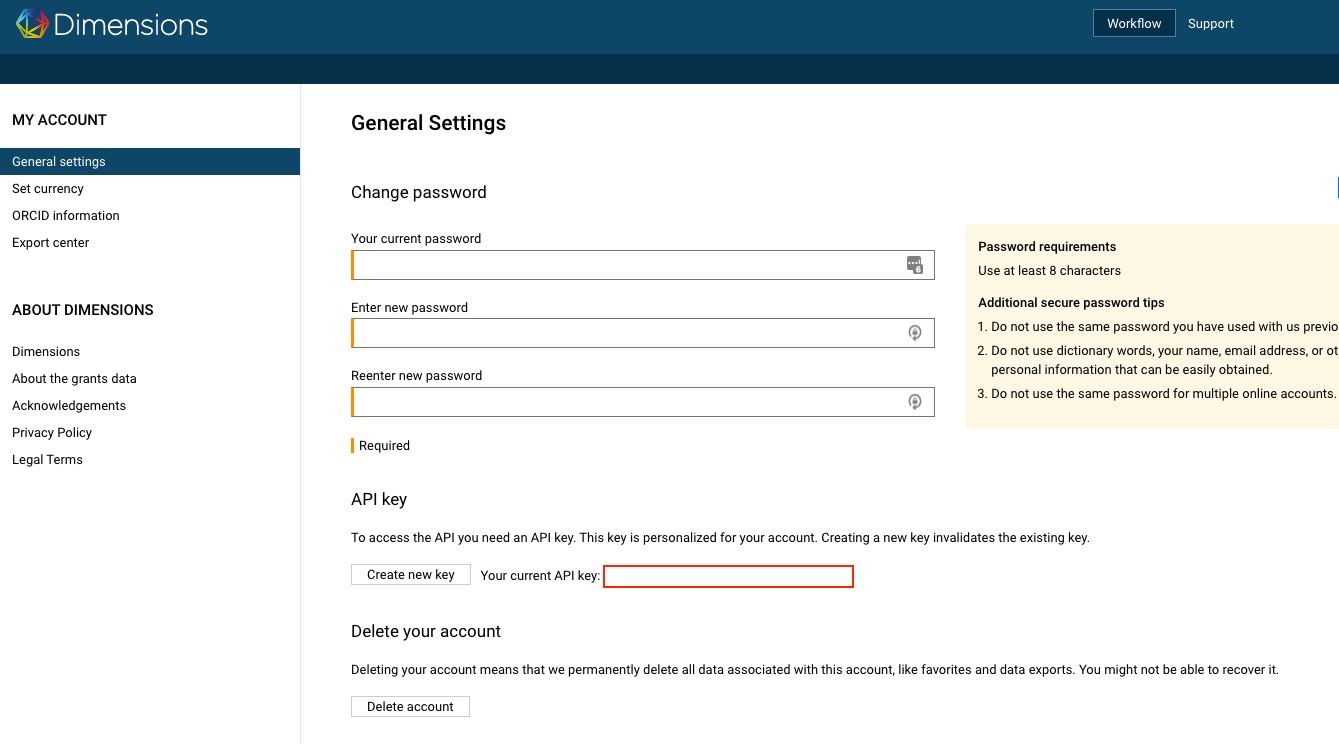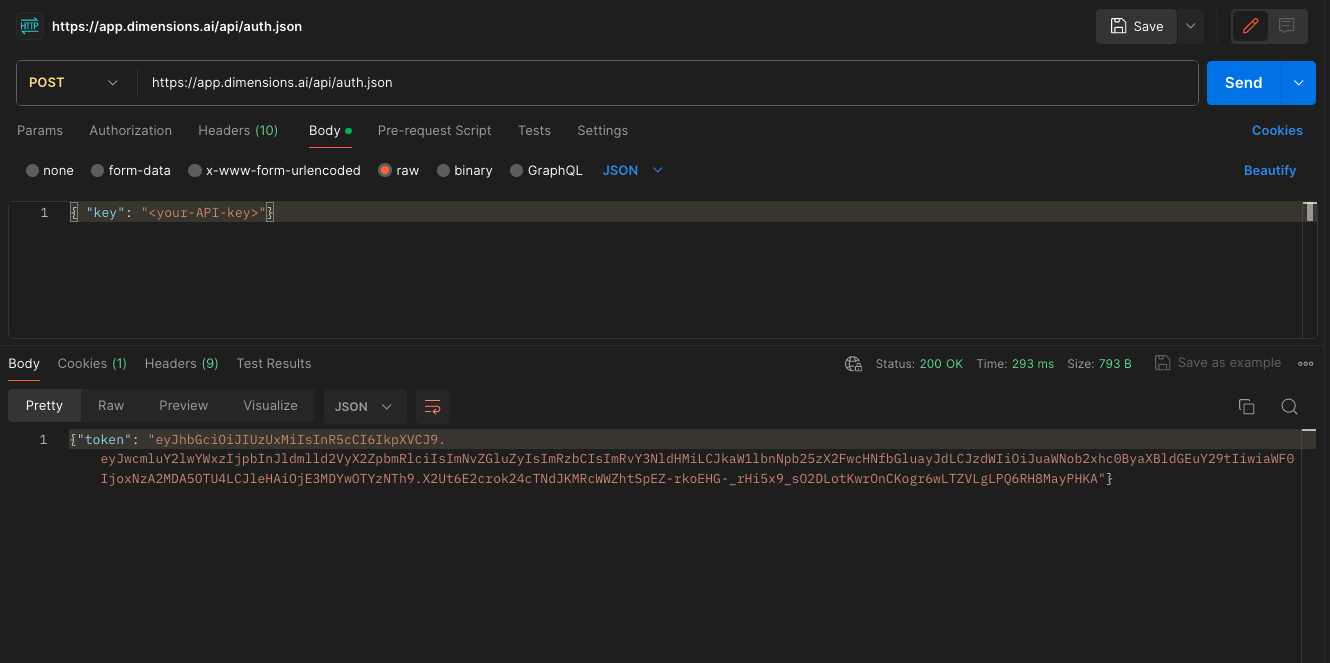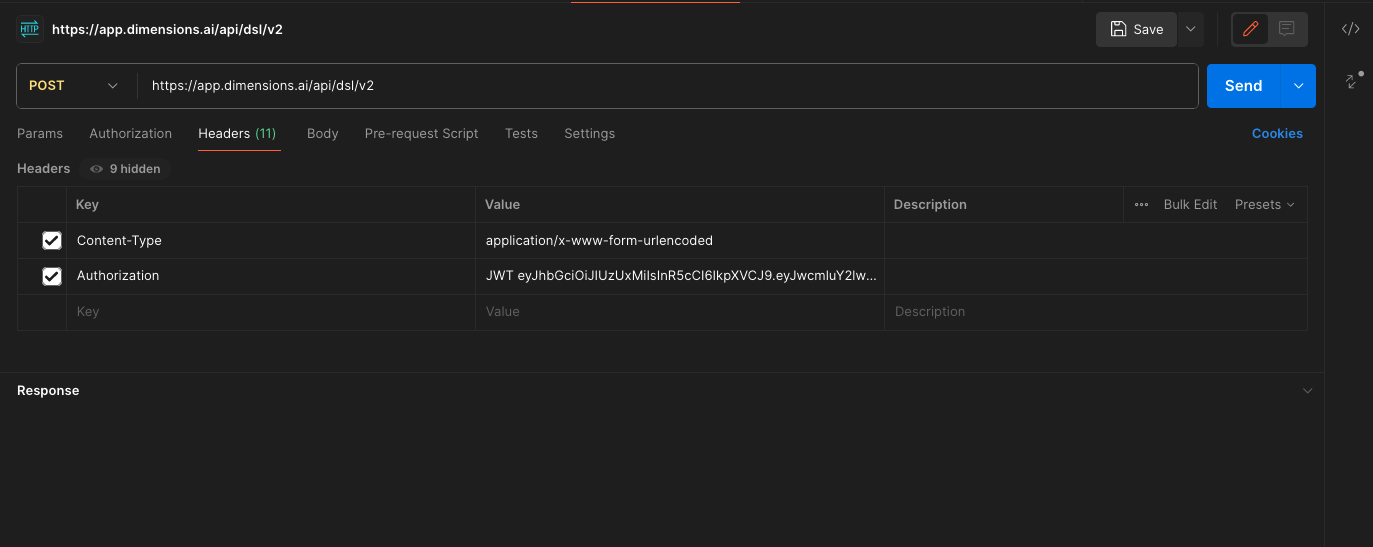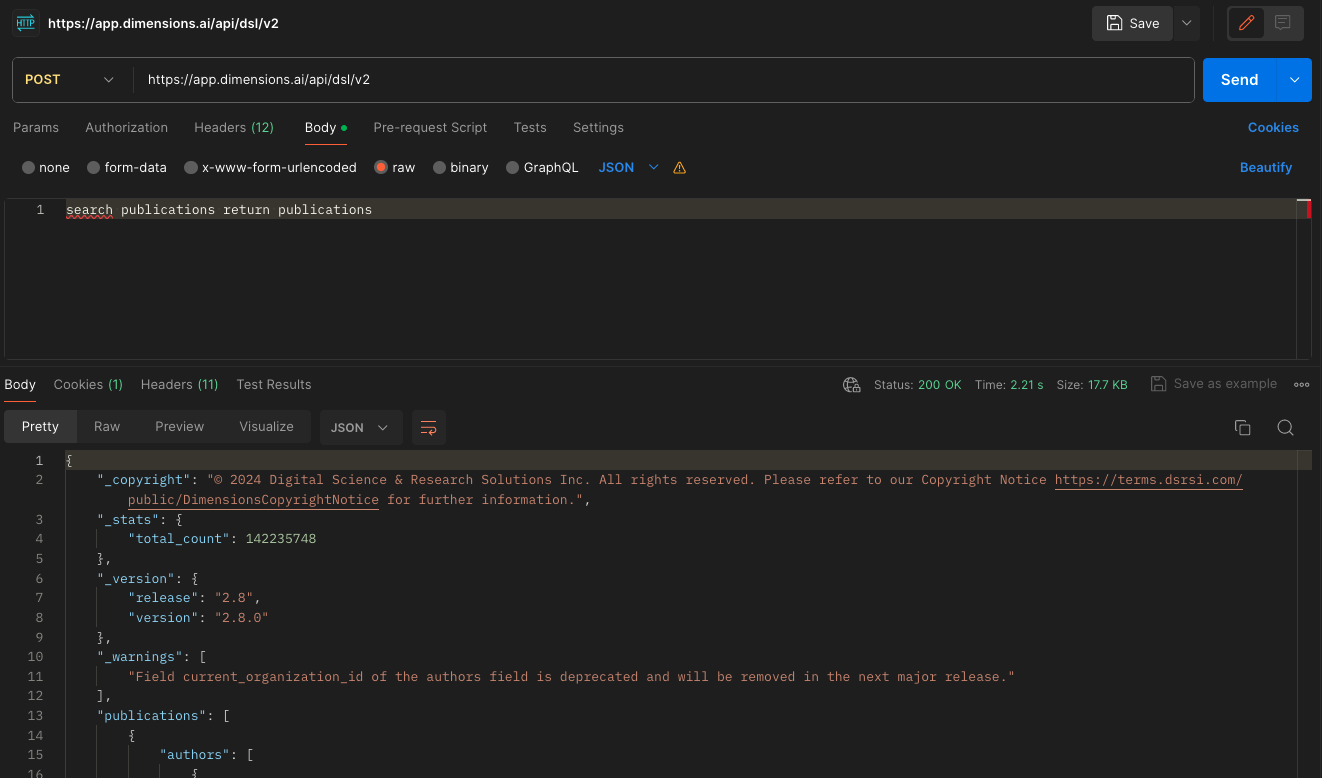API Access
The Dimensions Analytics API is subscription-only, so your Dimensions account needs to be activated for this service and subject to restrictions on use.
Getting an API Key
Once you have API access, you’ll be able to generate a new API KEY by going to the ‘My Account’ section of the Dimensions web application.

Querying the API
Querying the Dimensions API always involves two steps:
Sending your credentials (key) to the authentication url, in order to retrieve a query token.
Sending the token and a DSL query to the query url, in order to retrieve JSON data.
Important
The Dimensions Analytics API is limited to 30 requests per IP address per minute. The query token is valid for around 2 hours so it should be reobtained when it expires.
The diagram below provides an overview of these operations.

API Endpoints
The API includes two groups of endpoints: a) for authentication and b) for querying.
The authentication endpoint is the same for all versions of the API. The querying endpoints instead are for specific versions of the API.
Name |
Endpoint Path |
Description |
|---|---|---|
API Authentication |
|
The single authentication endpoint for all API versions. Returns a query token. |
Name |
Endpoint Path |
Description |
|---|---|---|
V1 (legacy) |
|
V1 API. Currenlty in maintenance mode. Removed in March 2022. |
V2 (latest) |
|
V2 API. Current major version of the DSL. |
Current (alias) |
|
Alias for current version of API. Will point to V1 till Dec 2021, then will point to V2. |
Current (alias, alternative path) |
|
Alias for current version of API. Will point to V1 till Dec 2021, then will point to V2. |
Important
Add your Dimensions URL to the endpoint path in order to obtain the final API URL. Eg if your Dimensions URL is https://app.dimensions.ai, your final authentication URL will be https://app.dimensions.ai/api/auth.
Upgrading from V1 to V2
Note
The API Version 1 is no longer available as of March 2022. Please use Version 2 instead.
The API V2 release may be backwards incompatible for some users, i.e. those who still rely on deprecated old fields. Therefore, we advise all users to review their code to ensure it does not break.
See the V1 deprecations full list for more details on what features are no longer available in V2.
Secondly, if you are upgrading your scripts from the API version 1 to version 2, you will also have to update the API connection endpoint. That is, from:
/api/dsl/v1(or/api/dsl, before Dec 2021)
To:
to
/api/dsl/v2(or/api/dsl, after Dec 2021)
Python : raw access
The following code snippet shows how to connect to the Dimensions API only using Python’s requests library.
import requests
# The credentials to be used
login = {
'key': "your API key"
}
# Send credentials to login url to retrieve token. Raise
# an error, if the return code indicates a problem.
# Please use the URL of the system you'd like to access the API
# in the example below.
resp = requests.post('https://<your-url.dimensions.ai>/api/auth', json=login)
resp.raise_for_status()
# Create http header using the generated token.
headers = {
'Authorization': "JWT " + resp.json()['token']
}
# Execute DSL query.
resp = requests.post(
'https://<your-url.dimensions.ai>/api/dsl/v2',
data='search publications return publications'.encode(),
headers=headers)
# Display raw result
print(resp.json())
The snippet above uses the key authentication method, which is the primary method for most API servers (see also this page for more information on how to obtain a key).
Note
Please note escaping rules in Python. For example, when writing a query with escaped quotes, such as:
search publications for "\"phrase 1\" AND \"phrase 2\""
in Python, it is necessary to escape the backslashes as well, so it would look like:
resp = requests.post(
'https://<your-url.dimensions.ai>/api/dsl/v2',
data='search publications for "\\"phrase 1\\" AND \\"phrase 2\\""',
headers=headers)
Similar escaping rules might apply to other programming languages than Python as well. Alternatively, Using triple quotes can be used to avoid having to escape quote characters.
Python : Dimcli
Dimensions APIs can be accessed also using Dimcli, an open-source Python client. Dimcli is a convenient way to connect to, query and analyze the results of Dimensions API.
import dimcli
dimcli.login(key="123456789qwertyuiop",
endpoint="https://app.dimensions.ai/api/dsl/v2")
dsl = dimcli.Dsl()
data = dsl.query("""search grants for "malaria" return researchers""")
print(data.json)
# {'researchers': [{'id': 'ur.01332073522.49',
# 'count': 75,
# 'last_name': 'White',
# 'first_name': 'Nicholas J'},
# {'id': 'ur.01343654360.43',
# 'count': 59,
# 'last_name': 'Marsh',
# 'first_name': 'Kevin'},
# .............
# ],
# '_stats': {'total_count': 8735}}
The API Lab includes several notebooks demonstrating the practical use of Dimcli. In particular, these two are a good place to start:
Note
Dimcli includes also a command line interface (CLI) that makes it easier to learn the grammar of the Dimensions Search Language. Calling dimcli from a Terminal opens an interactive query console with syntax autocompletion, persistent history across sessions, pretty-printing and preview of JSON results, export to HTML and CSV, and more.

curl + jq
This example shows a minimal way to query the API. This should be easily transferable to any other programming language or environment.
export DSL_TOKEN=$(curl https://<your-url.dimensions.ai>/api/auth.json -d '{"key": "your API key"}' -s|jq -r .token)
curl https://<your-url.dimensions.ai>/api/dsl/v2 -H "Authorization: JWT $DSL_TOKEN" -d 'search publications return publications' -s|jq
Note
Note that jq tool is used to extract a “token” value from the JSON response in the first request. In the second request, jq is used only to pretty print the result so it’s use is optional.
PowerShell
This is an equivalent example of the above CURL + JQ Example, but usable in the PowerShell enivornment.
$DSL_TOKEN = (Invoke-RestMethod -Uri https://<your-url.dimensions.ai>/api/auth.json -Method Post -Body (@{'key' = 'your API key'} | ConvertTo-JSON)).token
Invoke-RestMethod -Uri https://<your-url.dimensions.ai>/api/dsl/v2 -Method Post -H @{Authorization = "JWT $DSL_TOKEN"} -Body 'search publications return publications'
Postman
This examples shows how to set up Postman to query the Dimensions API. This can be achieved in two simple steps.
1. Obtaining a JWT token
Make a POST request to https://app.dimensions.ai/api/auth.json with body { "key": "<your-API-key>"}
This will return a JWT token, which should be noted as it will be used in the next step.

2. Using the token to query the API
Make a new POST request by adding the token to the Headers panel in this format: Authorization : JWT {theToken}.

Finally, Compose your query in the request body section:

Note
Another approach to get started with Postman is by using the cURL importer.
Third-party Libraries and Tools
- dimensionsR Library
The dimensionsR library is an open-source R-package to gather bibliographic data using the Dimensions API and the DSL.
- rdimensions Library
Another client library rdimensions for interacting with the Dimensions API from the R environment.
- Sidewall Python Library
The Sidewall library is a Python package providing object classes for Dimensions entities, fetches data incrementally, caches results, copes with rate limits, and more, to make working with Dimensions in Python more natural.
- Biblioshiny
Bibliometrix facilitates bibliometric analysis, using several APIs including the Dimensions Analytics API. Biblioshiny is a Shiny app, providing a web-interface for bibliometrix.